Vietnam March 6 & 7, 2017
A Little Bit of Vietnam History
NhaTrang |
Saigon (Ho Chi Min City) |

A Little Bit of History
Vietnam like all Asian Countries has thousands of years of history. Human fossils dating to around 500,000 BC have been found in caves in northern Vietnam. By 2500 BC things were organized enough that there were recorded Vietnamese Dynasties, but how much of what is today Vietnam they included is not clear. In 111BC China annexed Vietnam and held it until 939 AD. At the end of this period the Vietnamese managed to drive them out with guerrilla warfare and when an army was sent to put this down, they lured their ships up a river at high tide, then planted metal spears in the river below this. When the tide went out and the ships tried to go downstream, they were torn apart and the Vietnamese massacred the army.
There were other conquerors, one of whom paid no attention to history and met the same fate. By the early 10th century, Vietnam had gained autonomy, but not sovereignty. I will skip the other dynasties who came and went during a period that saw them successfully repel three Mongol invasions. The Vietnamese dynasties reached their zenith in the Lê dynasty of the 15th century, especially during the reign of Emperor Lê Thánh Tông (1460–1497). If you every study Vietnamese art you will hear the Tong period mentioned.
Very early North and South Vietnam differences appeared. The North had both copper and tin and could make bronze, while the South had only tin. In the south a tribe known as the Champa gradually emerged. They were farmers and expert sailors, so good that they became slavers, kidnapping people and selling them. There is much evidence that the early Vietnamese, probably the Champa, were traders. Roman coins have been found in the south.
During what we call the Vietnam War and they call the American War, pilots flying over the Mekong Delta saw miles of old canals, probably used in this trade. Although at the end of the Vietnam War the North had a more dynamic economy, the South has now surpassed the north. It is not beyond the realm of possibility that there will be a civil war in Vietnam.
Vietnam today maintains a culture that has some vestiges of Chinese influence, as well as French, especially in the colonial buildings they left in the south. Despite all the people who have conquered Vietnam, the Vietnamese have their own distinctive culture. This despite the efforts of the Chinese in the Ming Dynasty (brief period in the early 15th century) to try to completely eradicate Vietnamese culture, forbidding the use of their language and trying to impose their writing system etc.
The society was matrilineal. When a man married, he moved into his wife’s home, and separate living quarters were added lengthwise to the structure. The result is a long house reminding me of some American Indian long houses. One thing that was preserved from the Chinese until the mid 20th century was the use of administrative exams to determine who government officials would be.
Unlike China and Japan, the Vietnamese do not keep up their historical artifacts. When they fall into disrepair, they simply tear them done and build something else. Consequently, there are few things in Vietnam that are older than 100 years. For one thing, they can’t afford it. There is still a lot of poverty, the per capita income has risen from $800 per year to $1100 in the last 4 years. My observations support there being some very rich, and the rest of the country struggling to get by. One of our speakers, tongue in cheek, described Vietnam as the most capitalistic communist country she ever saw.
Vietnam as you probably remember is shaped like a snake (dragon?) running along the southeast coast of Southeast Asia giving it 1400 miles of coastline. There is not a great deal of arable land here, but they pioneered in wet rice farming and do engage in that as well as some terraced rice growing. That is successful enough that they export rice. In the area around Phu My, our port for Saigon, they get 2 crops a year, but in the Mekong Delta they can grow 4 crops a year. Much of the work is still done as it was thousands of years ago. There are now machines that will replace the back breaking work of planting the seedlings, but few can afford them.
NhaTrang March 6
Nha Trang is a resort area, which in Asia is well known for its beaches and scuba diving and has developed into a popular destination for international tourists, particularly Chinese and Russian, as well as the Vietnamese. Nha Trang Bay is widely considered as among the world's most beautiful bays and I can agree! The ocean is blue, and there are occasional little islands, plus a backdrop of mountains.
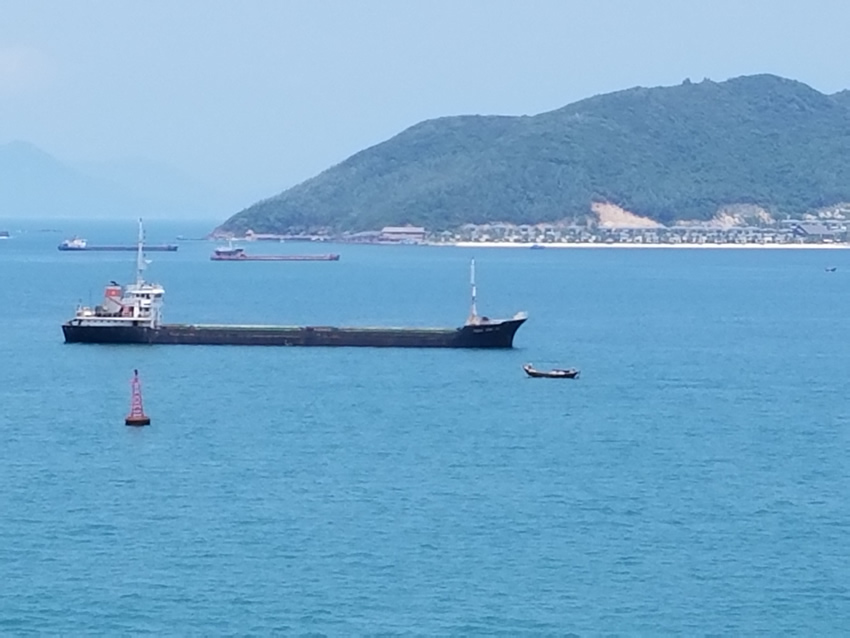
When we first approached Nha Trang about 6 AM I was surprised to see a group of tall buildings. I am guessing that they are resort hotels, but cannot verify that. The harbor is also beautiful, but full of small tug like boats with tires all around them – judging by the harbor with these boats rafted off from one another – I am guessing that nudging one another is hardly a rare occasion.
Today I broke with the group and took a ship tour because there were things in the city that I wanted to see. Our first stop was at a hand embroidery shop, what I consider the obligatory tourist stop in hopes that you will buy. The work was beautiful and several folks in the tour did buy. It takes about 5 months to make each one, and the price reflects it. They explained how they take a picture, then trace it onto paper. A worker uses a small needle to make holes in the paper of the design. This then is placed on top of the material that will be used for the finished product, usually silk, and the embroiders work from that. The embroiders serve a 2-year apprentice ship. These young girls work 8 hours a day, 6 days a week. Every two hours they get a break to exercise their eyes, because it is very close work. The hostesses had on the most beautiful dresses, slit on each side with pants underneath, which were not for sale. Of course they are all thin as the proverbial church mice. I could have been tempted to buy one of the embroideries except the price and no place at home where it would not look sadly out of place.
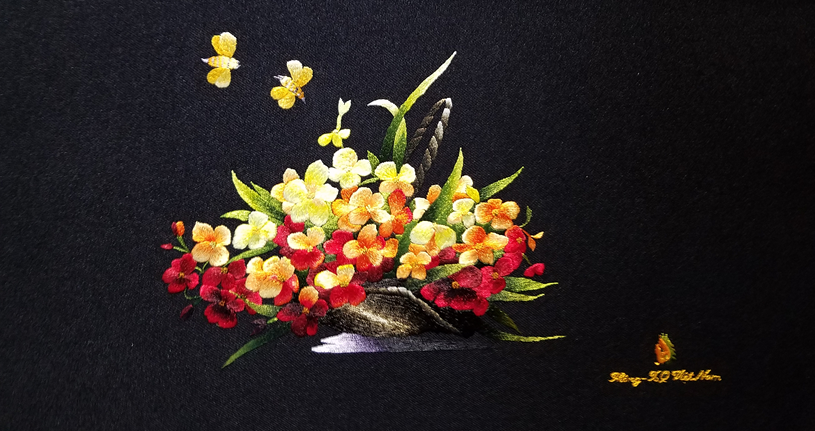
One of the pieces of embroidery.
The Lon Son Pagoda, one of the famous sights in Nha Trang, has a statue of a 24 meter high white Buddha sitting on a lotus blossom. Of course it is at the top of a hill, and requires navigating more than 150 steps to reach it. On the trip up to see the Buddha there is a statue (Can you call a figure lying down a statue?) of the reclining Buddha.
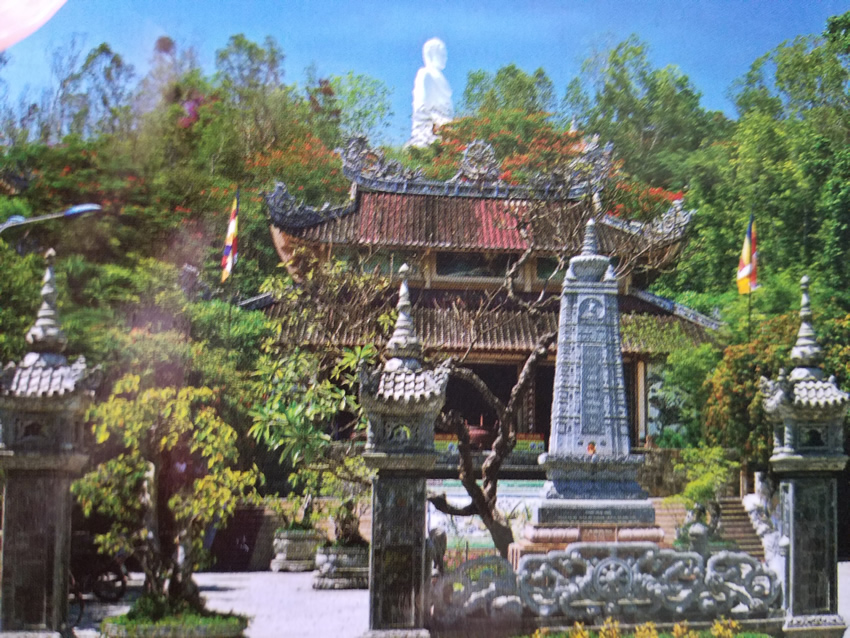
Once at the top I was rewarded not only with a close view of the huge Buddha, but views.of the country below. I walked around the Buddha, taking many pictures, which is overkill. But then, I don’t plan to be back again.
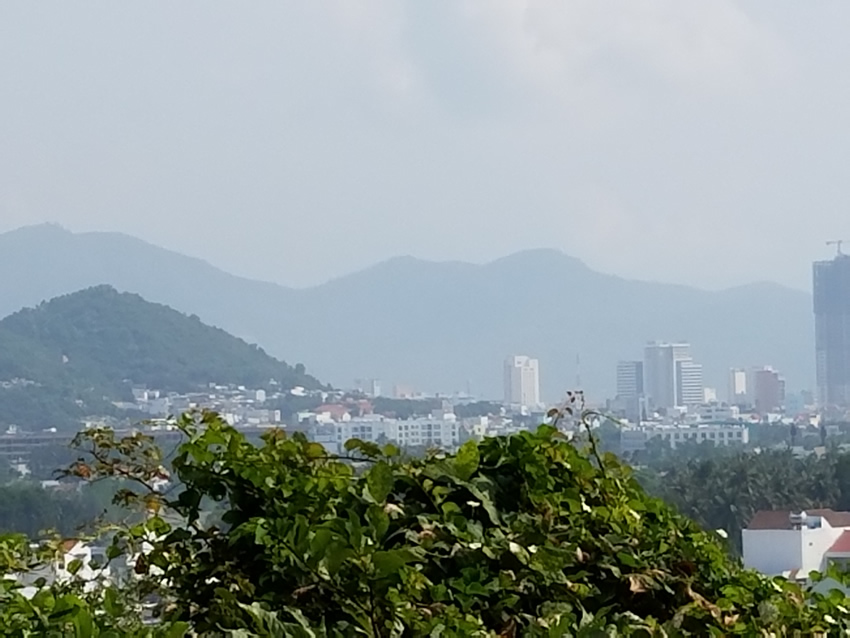
One of the many 360 degree views from the Pagoda. It is a very peaceful scene despite many tourists.
At the foot of this pagoda we watched as a policeman bargained with a man on a motor bike selling fish. He eventually bought the fish, which was in a plastic zip lock bag with water, and it was probably still alive, To some it looked like an eel. I did not hazard a guess.
After descending all the steps from the Pagoda we visited another Nha Trang famous landmark, a Hindu temple called the Thap Ba Ponaga. It was built by the Chama People between 800 and 1200 AD. This is one of the few items in Vietnam that has survived this long and there are even attempts to restore it. But one can still see where it is crumbling, a reminder that indeed parts are over 1,000 years old. Again, more steps (Why do all these things have to be on the top of a hill?) Once up at the temple itself, I found what looked like a small festival, but with very few people. There was music playing, and it sounded like Western music (For the tourists? I don’t know.) Besides the main temple there are two smaller ones, one on each side. Both here and at the Buddha Temple, the smell of sandalwood incense was strong, which to me is pleasant.
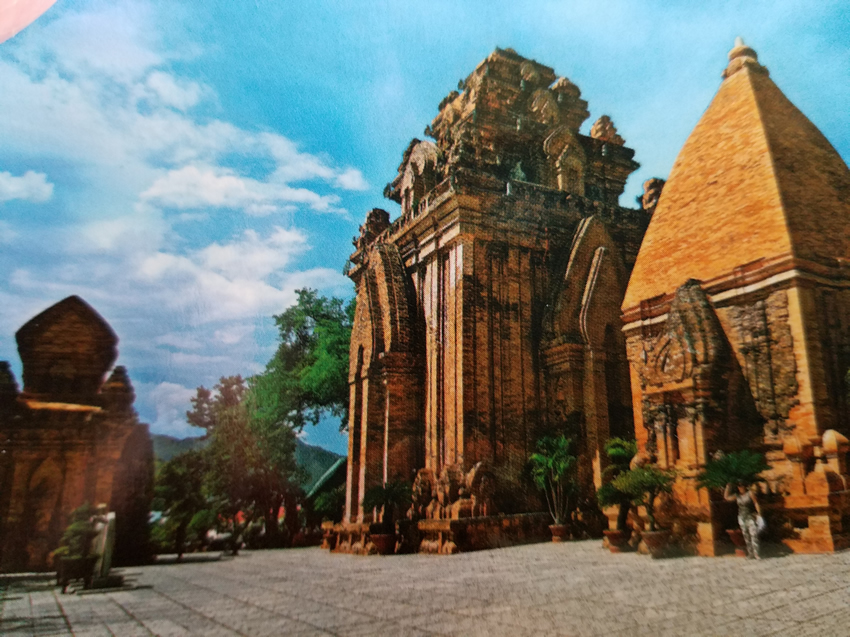
Coming down from this temple, one of the women in our group was separated from her husband. She has macular degeneration and was having trouble seeing. I took her arm with my one free hand (I had a cane in the other) and was telling her where each step was and guiding her. Before I knew it I felt a hand on my other elbow helping me to descend and to keep my balance. After we were down I looked around to thank the individual and saw a young Chinese couple. It was just one of those beautiful things that happen when you are alone.
The Cai River that empties into the Bay was across the street from the Hindu Temple. On it there were many small boats, not pleasure boats, but probably fishing boats.
The last stop, a market, was where we experienced the real Nha Trang. The narrow streets, the constant roar of motorbikes and cars, with horns being indiscriminately used by both. Add to that the different fragrances, occasionally one could call it an odor, and I think that you may have the real southeast Asia. But, given that this is my first stop in this area, I reserve judgement. To cross the street you just keep going, the cars and motorbikes will avoid you, but if you hesitate you are lost.
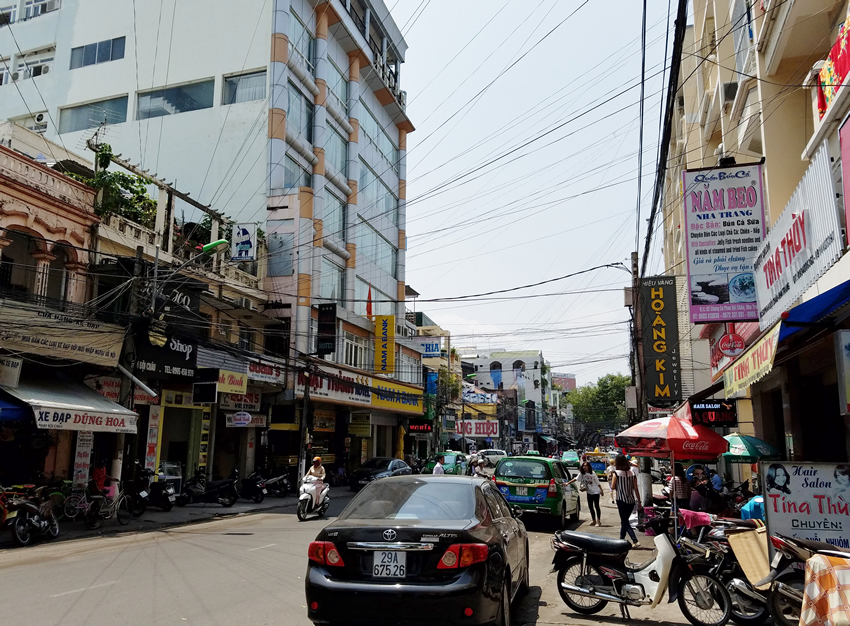
There are no traffic lights in this city, instead many roundabouts. In the center is either a statue, or other decorations such as flowers. There is a median between the different lanes where there are trees. There were small evergreens about 4 feet high that had branches cut off in a circle at various intervals.
In Vietnam they drive on the left hand side. Inherited, no doubt, from the Japanese. The Chinese except for Hong Kong drive on the right.
One of the ship lecturer’s did a session on how Honda reshaped Southeast Asia. By figuring out how-to motorize a bicycle. This invention liberated people. Previously limited to just bicycle or walking they could only travel a limited distance. With this new device more distant markets were open to them. Women could operate these thus it liberated them too.
They carry all sorts of things on these bikes. I saw a bicycle with a 6 feet long, 3 feet high chest of drawers on the front going down the street. Unfortunately he appeared and disappeared before my camera was activated. The speaker showed us many pictures of the loads that they can place on these things and still navigate. I believe that some of then were loaded with more items than would fit into a medium size car!
This change is not all positive, the motor bikes contribute to pollution, but worse, the death rate for these vehicles is extremely high, surpassing other countries by a large margin. Unfortunately, the next day in Saigon those on our bus saw the aftermath of such an accident. At the same accident I also saw a policeman chasing another man across the street kicking him in the behind all the way.
The housing is oblivious to any thought of zoning. As you drive along a street a beautiful 3 story house appears, set among one story run of the mill houses. This occurred many times.
We returned to the ship about noon because sailing time was 1:30. That was enough time for me to again leave the ship and venture down to the pier where there were all manner of vendors, selling many of the same things we had seen in the city market, but also some different things. Nothing has a price marked on it, and once you get the vendor to give you a price, you are supposed to haggle. I am not very good at it, but in no case, except the 10 post cards sold by a little boy at the Pagoda for $1. did I pay the asking price. I even bought a Vietnamese Hat, those conical things with a net string to hold it on. A completely worthless object, but I figured that she needed the $2 worse than I did. And I had fun with it.
Where we were moored, there were cables above the harbor that in the day time carry gondolas from the shore to the amusement park. When we arrived it was not yet operating, however, when we left they had to stop the gondolas in mid-air and tighten the cable so we could go underneath.
Saigon (Ho Chi Min City) March 7
The morning we left for Saigon my phone decided that it guessed that Vietnam time was ok and it reported the correct Vietnam time. But, because Singapore is on daylight time, that night we had to set our watches ahead an hour and my phone still wants to register Vietnam time.
Saigon’s location is too far up the river for ships our size to navigate. Consequently, we docked at Phu My, which is a two-hour bus ride from Saigon. In the states with our roads, provided of course that it was not rush hour, it would be less than an hour’s trip.
Although officially called Ho Chi Minh City, abbreviated HCMC, many people still refer to it as Saigon. The name should be in two parts Sai (cotton) and gon (wood). Saigon is the largest city in Vietnam and was the capital of the French colony of Cochinchina and later of the independent republic of South Vietnam (1955–75).
The guide that I had on my independent ship tour had the kind of childhood and young adulthood that was reminiscent of our country during and after our Civil War, only in Vietnam the losers were treated far more harshly. The guide’s father was a colonel in the South Vietnam army while some of his uncles fought for the Vietcong. When Saigon fell, his father was shipped to a “reeducation camp,” for several years during which he lost his health. As things returned more to normal, our guide eventually fell in love with a woman whose father was a colonel in the Vietcong. They could not marry until after the guide's father died, which due to poor health from the camp was premature.
The guide was 16 in 1975 and has a vivid memory of the war as well as the results of the loss by South Vietnam. The war itself deprived him of an education and when things finally settled down he started from nothing. Despite my being told that only 8% of the population remembers the war, it is obvious that for those who had painful young adulthoods it will never be forgotten because their lives were turned upside down by it.
Vietnam seems to be confused about religion. To get a job you must sign a paper stating that you have no religion, but there are as many as 50 million Catholics in Vietnam, particularly in the South. A beautiful replica of Notre Dame in Paris exists in Saigon.
On the road to Saigon from the port I saw statues of Buddhas for sale, and several Buddhist temples. One of the ship’s lecturers told us that the reason the Communists do not like religion is that most maintain that there is a higher authority than the government. They tolerate Buddhism because theoretically they do not believe this. However, when I see people praying to Buddha with the same reverence that I see in Christian churches, I do wonder.
To cope with an ever-expanding population each family is supposed to have only two children, but in the rural areas this is not always followed.
All along the highway, and in places in the city, are clusters of one story shops as well as people selling things along the highway. What was puzzling was the frequent occurrence of large open shelters in which plastic chairs are set out, like an auditorium.
Saigon is organized in numbered districts just like Paris, no doubt a French contribution. Besides this, one of their best contributions was to Vietnamese writing. In 1902, under their influence, the Vietnamese written language abandoned the Chinese characters and started using an alphabet very similar to ours. There are 29 characters in their alphabet, and like Spanish, a few letters whose only changed appearance is the addition of a mark above the letter. For example a plain “D” is one letter, while a “Ď” with a mark on it is a different letter and pronounced differently. To me this shows that when an occupying force forces a change that is seen by the populace as helpful they never slip back.
Between Phu My and Saigon we saw many rice paddies in different stages of ripeness. There were many small streams, and some with buoys indicating that they are navigable to some type of boat. There were also cows grazing in some areas.
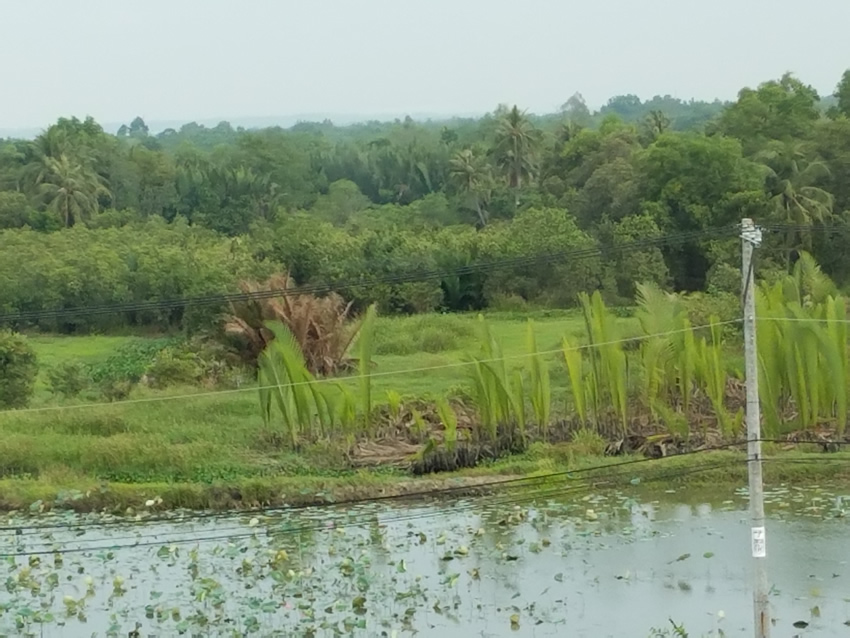
Off the subject a bit, but we were told that by 2030 they expect 2/3 of the Mekong Delta to be underwater and they are trying to decide where they will move all the people who live there.
The Reunification Palace, formerly the Presidential Palace of the brief republic of Vietnam, is now a museum. Built by the French it is a very attractive building and the rooms inside where formal meetings were held, as well as the presidential living quarters were very opulent.
We visited the conference room where the cabinet officially agreed to surrender after which they were handcuffed and led out of the building and bundled off “reeducation camps”. In the basement are reinforced bunkers with everything one needs to manage a war including maps and communication equipment, plus an underground tunnel to the international airport. What I don’t know is whether it was ever finished.
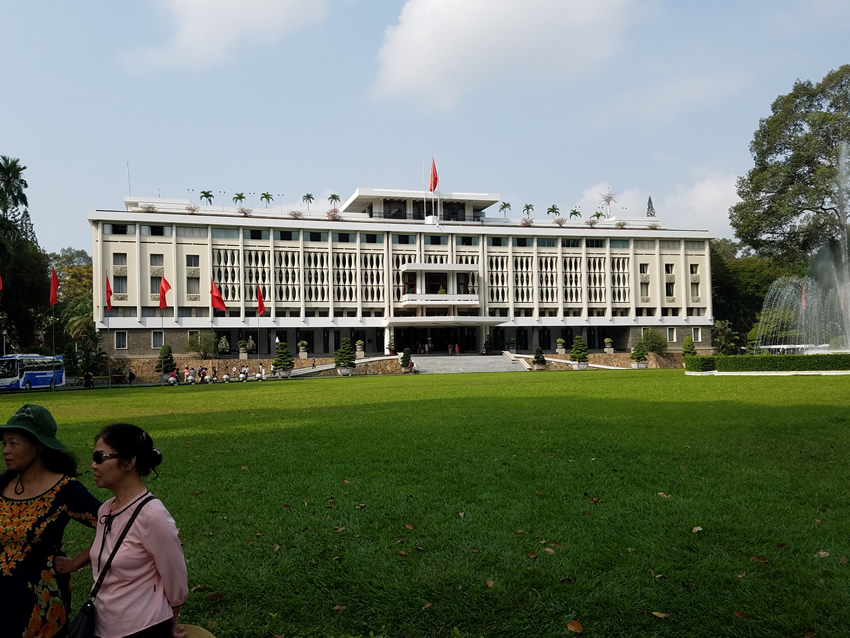
Before we arrived at the Reunification Palace the guide warned us that we might have to walk a ways to get there because the previous day (Sunday) about 2000 school girls held a protest, wanting change. We were never told what the change was that they wanted. We were also told that there is freedom of speech, but not violence. (???) In dictatorships one always has to listen more to what is not said, than what is said, but when the guide was discussing how his family was affected by the war, and being on the losing side, he was not parroting the official line.
Our next stop was the Museum of Ho Chi Minh City. It was not worth a stop. There were some relics like an old weaving machine and tools used in shoe making, but the general feeling was that they could not, or would not, make it a real museum.
The roads, both in Saigon and on the way there have a large motorbike lane. Every day 400 new motorbikes are registered in Saigon. However, except for one small area, I never saw a physical barrier between the bike lanes and cars. To see how close everyone comes, cars, busses, small trucks, and motorbikes is to wonder that there are not more accidents. He who is not aggressive will not get anywhere in this traffic. Notice they are all wearing helmets. A little PR comparing survival rates in accidents between those wearing helmets and those not, plus a little enforcement did the trick.

Lunch, a buffet, was at the New Windsor Hotel. I have come to the conclusion that in Asia no restaurant can be on the first floor. Many we visited were on the second floor, but this one was on the 7th. The fragrance in the wide hallway leading to the dining room was fantastic – I loved it. Besides a more than substantial lunch I ate dragon fruit. It has a reddish shell, and the fruit is white with black specks. The taste resembles a pear. They serve it cut up like a melon, but the pieces are much smaller.
Unlike pristine Shanghai where there are few wires visible, Saigon, bunches the telephone, cable, and Internet cables all together and hangs them in the air. The picture below is a junction - and you can't see the diameter of these bunches which is 9 to 12 inches.

After lunch we made our way to the Bitexco Building. It’s attraction is a 49th floor observation deck and platform. The platform extends out from the building but is not transparent, and is only one part of the deck which encircles the building. No, I did not walk up those 49 floors.
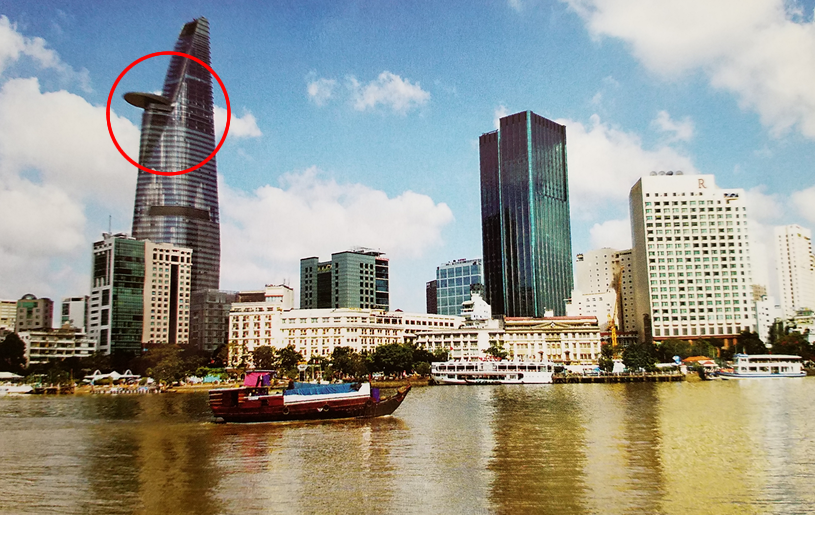
The views were worth the trip. In almost every direction that I looked there were buildings; high rises mixed with much lower buildings. We could see the Saigon River and some of the canals that lead into it. There was one area that is currently empty and dirt, but I suspect that in 5 to 10 years it will have buildings on it. This deck gave one an excellent view of the city which goes on in all directions to the horizon.

This building was built by a real estate company that builds all the new apartment houses. Like China, however, many are empty because they are too expensive for the populace. Who is financing all of this was never divulged, if our guide even knew, but I have a feeling that there could eventually be a bust when someone has to pay the piper.
The Saigon Post Office is another tourist must. Don’t laugh, the building looks like a train station, but it is a functioning post office and always was. Inside is a beautiful concave ceiling. The Vietnamese have taken advantage of the motif and added windows that pretend to sell train tickets. But what is clever is that they sell postcards, and the tourists write them, buy stamps, and mail them from there. Sounds like a good capitalist idea to me.
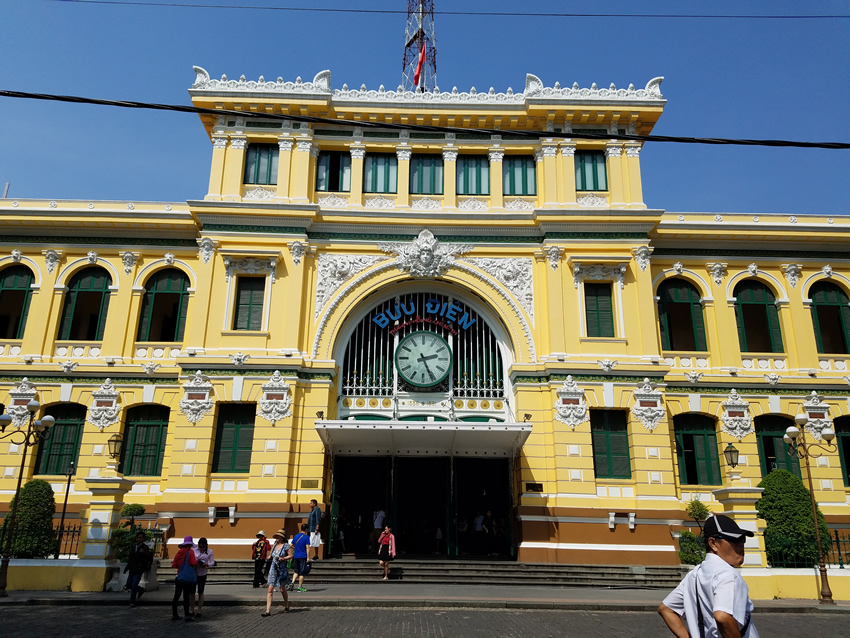
The country seems to be the very rich and the very poor. Many of the cars that we saw were Lexus, BMWs and the like. None of the inexpensive cars that one of our Beijing guides said were being sold in Vietnam were visible.
With financing from Japan, they are building their first underground train which is expected to be open in 2020. They are also constructing a monorail. In several places I saw a part that was complete, then a space, then another in 100 feet. There are no expressways as we know them, but there are not enough cars to justify them either. Just motorbikes!